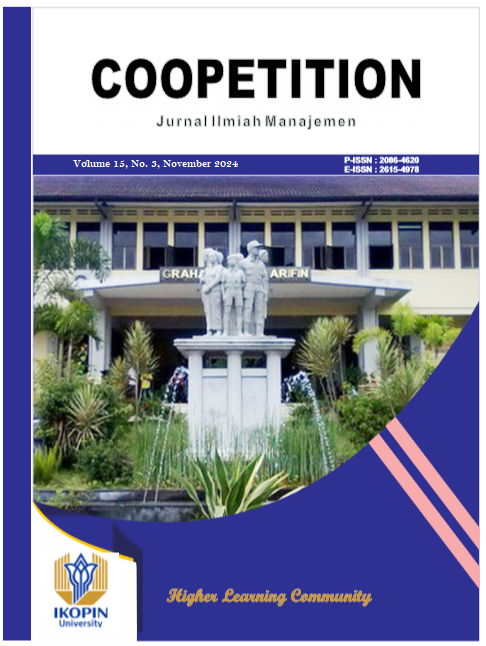Transformasi Kesehatan Masyarakat Melalui Peningkatan Fasilitas Sanitasi di Kecamatan Tomo: Analisis dan Proyeksi 2024
DOI:
https://doi.org/10.32670/coopetition.v15i3.4819Keywords:
sanitation facilities, infectious diseases, public healthAbstract
Sanitation facilities, especially defecation facilities, play a vital role in reducing the spread of infectious diseases associated with poor sanitation. Tomo District has made various efforts to improve access to sanitation, including the construction of public toilet facilities and health education campaigns. However, there are still challenges in achieving universal sanitation coverage. This study aims to identify the distribution of defecation facility use in Tomo District from 2019 to 2021, measure the level of public health in Tomo District during that period. analyze the relationship between the type of defecation facility and the level of public health. And projecting changes in the use of drinking water sources and disease prevalence. This study uses a quantitative approach with descriptive and inferential analysis to evaluate the relationship between the independent variables (defecation facilities) and the dependent variable (health level). With the projection of data on the use of drinking water sources and the prevalence of infectious diseases until 2024, we can see the expected trend if the assumption of an increase or decrease of 10% each year is met. These results provide an important picture for planning and decision making in efforts to improve public health in Tomo District. The results showed a significant relationship between the use of private latrines and a decrease in the prevalence of infectious diseases such as diarrhea and digestive tract infections
Downloads
References
Badan Pusat Statistik. (2019-2021). Pendataan Potensi Desa (Podes). Jakarta: Badan Pusat Statistik.
Cairncross, S., Hunt, C., Boisson, S., Bostoen, K., Curtis, V., Fung, I. C., & Schmidt, W. P. (2010). Water, sanitation and hygiene for the prevention of diarrhoea. International Journal of Epidemiology, 39(suppl_1), i193-i205. https://doi.org/10.1093/ije/dyq035
Dinas Kesehatan Kecamatan Tomo. (2019-2021). Laporan Kesehatan Tahunan. Sumedang: Dinas Kesehatan Kabupaten Sumedang.
Dreibelbis, R., Winch, P. J., Leontsini, E., Hulland, K. R., Ram, P. K., Unicomb, L., & Luby, S. P. (2013). The Integrated Behavioural Model for Water, Sanitation, and Hygiene: A systematic review of behavioural models and a framework for designing and evaluating behaviour change interventions in infrastructure-restricted settings. BMC Public Health, 13(1), 1-16.
Fewtrell, L., Kaufmann, R. B., Kay, D., Enanoria, W., Haller, L., & Colford Jr, J. M. (2005). Water, sanitation, and hygiene interventions to reduce diarrhoea in less developed countries: A systematic review and meta-analysis. The Lancet Infectious Diseases, 5(1), 42-52.
Prüss‐Ustün, A., Bartram, J., Clasen, T., Colford, J. M., Cumming, O., Curtis, V., ... & Cairncross, S. (2014). Burden of disease from inadequate water, sanitation and hygiene in low‐and middle‐income settings: a retrospective analysis of data from 145 countries. Tropical Medicine & International Health, 19(8), 894-905.
UNICEF. (2014). Water, Sanitation and Hygiene (WASH). New York: United Nations Children's Fund (UNICEF).
World Health Organization (WHO). (2015). Global action plan for water, sanitation and hygiene in health care facilities. Geneva: World Health Organization.
Downloads
Published
How to Cite
Issue
Section
License
Copyright (c) 2024 Coopetition : Jurnal Ilmiah Manajemen

This work is licensed under a Creative Commons Attribution 4.0 International License.


















